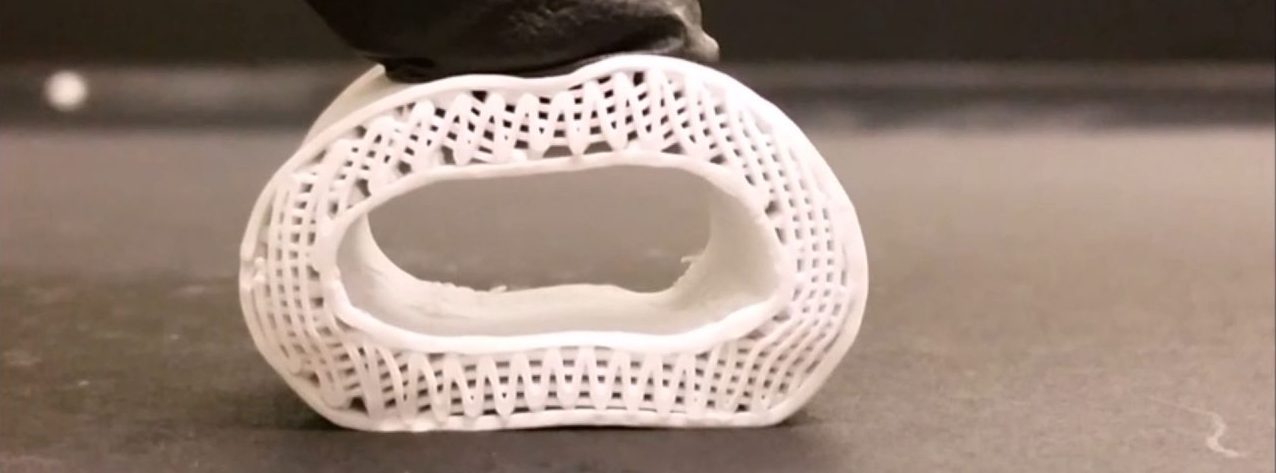Medical device and MedTech insights, news, tips and more
3D Print-On-Demand Bone Could Quickly Mend Major Injuries
October 3, 2016

If you shatter a bone in the future, a 3D printer and some special ink could be your best medicine. Researchers have created what they call “hyperelastic bone” that can be manufactured on demand and works almost as well as the real thing, at least in monkeys and rats. Though not ready to be implanted in humans, bioengineers are optimistic that the material could be a much-needed leap forward in quickly mending injuries ranging from bones wracked by cancer to broken skulls.
“This is a neat way to overcome the challenges we face in generating bone replacements,” says Jos Malda, a biomaterials engineer from Utrecht University in the Netherlands who was not involved in the work. “The scaffold is simpler to make than others and it offers more benefits.”
Surgeons currently replace shattered or missing bones with a number of things. The most common option is an autograft, where a piece of bone is taken from a patient’s own body, usually from a hip or a rib, and implanted where it’s needed elsewhere in that same patient’s skeleton. Surgeons prefer autografts because they’re real bone complete with stem cells that give rise to cartilage and bone cells to provide extra support for the new graft. (Humans can’t regrow entire skeletons from scratch with stem cells, but existing bone can signal stem cells where to grow and what to grow into.) What’s more, because the new bone replacement comes from a patient’s own body, there’s no risk of immune rejection. But only so much of a person’s skeleton is available for grafting, and doing so tacks on another painful surgery and recovery for the patient.
Another bone replacement option is creating a scaffold for bone to grow on. These scaffolds, made of both natural and synthetic materials, work like the framing of a building. When inserted into the body, stem cells latch onto the structure and differentiate into cells that start to build bone, much as construction workers assemble walls, floors, and glass around a skyscraper’s steel girders.
Or, at least, that’s how it should work—unlike in an autograft, stem cells don’t always turn into the needed bone or cartilage because of the scaffolds’ material makeup. Researchers have gotten stem cells to grow on a ceramic material called calcium phosphate (CaP), but this scaffold is stiff and brittle, making it difficult to implant into patients. To make matters worse, the immune system occasionally sees these scaffolds as foreign and attacks them, preventing any bone growth at all. And if a scaffold is to be used to regenerate small bones, such as many of those found in the face, for example, doctors worry that it would take too much time and money to make them from CaP.
Researchers at Northwestern University, Evanston, in Illinois are working on a material to remedy all of these issues. Their hyperelastic bone is a type of scaffold made up of hydroxyapatite, a naturally occurring mineral that exists in our bones and teeth, and a biocompatible polymer called polycaprolactone, and a solvent. Hydroxyapatite provides strength and offers chemical cues to stem cells to create bone. The polycaprolactone polymer adds flexibility, and the solvent sticks the 3D-printed layers together as it evaporates during printing. The mixture is blended into an ink that is dispensed by the printer, layer by layer, into exact shapes matching the bone that needs to be replaced. The idea is, a patient would come in with a nasty broken bone—say, a shattered jaw—and instead of going through painful autograft surgeries or waiting for a custom scaffold to be manufactured, he or she could be x-rayed and a 3D-printed hyperelastic bone scaffold could be printed that same day.
“We’re printing flexible scaffolds that will encourage bone to grow through and around them,” says Ramille Shah, a material science engineer and co-author on the study.
To test their material, the team first tested their 3D-printed scaffold as a material to fuse spinal vertebrae in rats. Their goal was to see whether their material could lock two adjacent vertebrae in place as well as other scaffolds commonly used to treat spinal injury patients. Eight weeks after the Northwestern researchers implanted the hyperelastic bone, they found that new blood vessels had grown into their scaffold—a necessary step to keep bone-forming tissue alive—and calcified bone started to form from the rats’ existing stem cells. The combination fused the vertebrae more efficiently than the controls that received either a bone graft from a donor or nothing at all, the researchers report today in Science Translational Medicine.
Read Full Article – Source: Print-on-demand bone could quickly mend major injuries | Science | AAAS
Author – Jessica Boddy
Photo Credit – Science/AAAS
